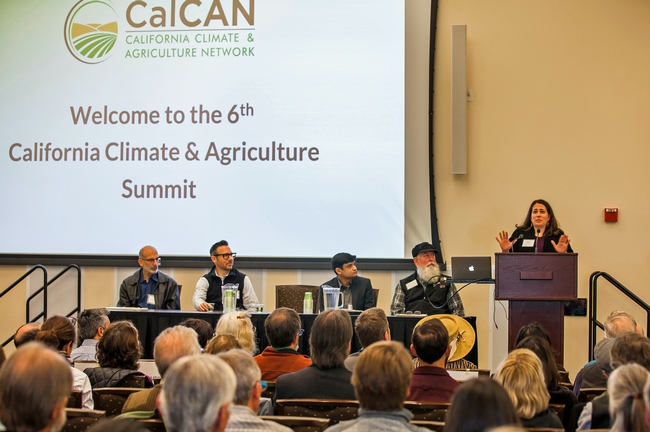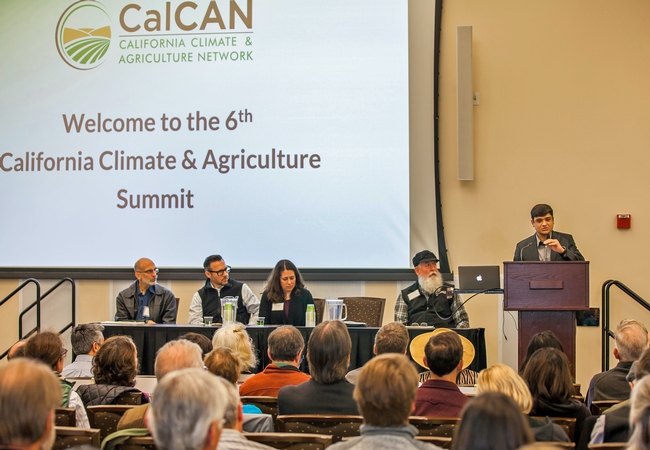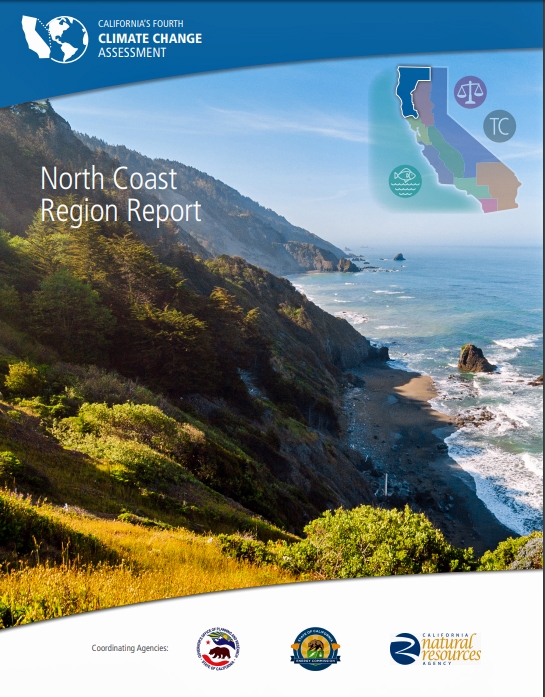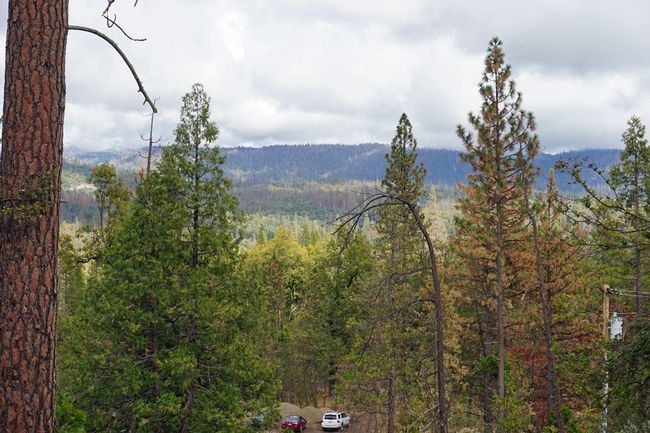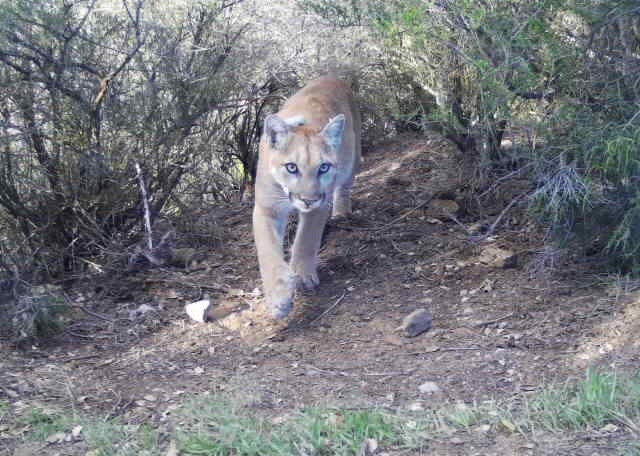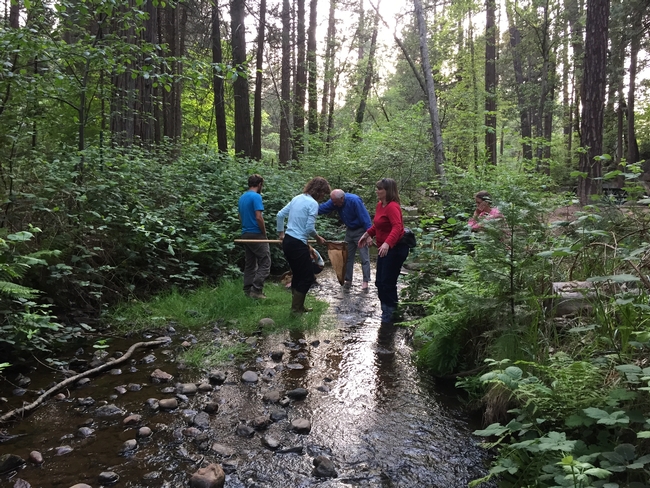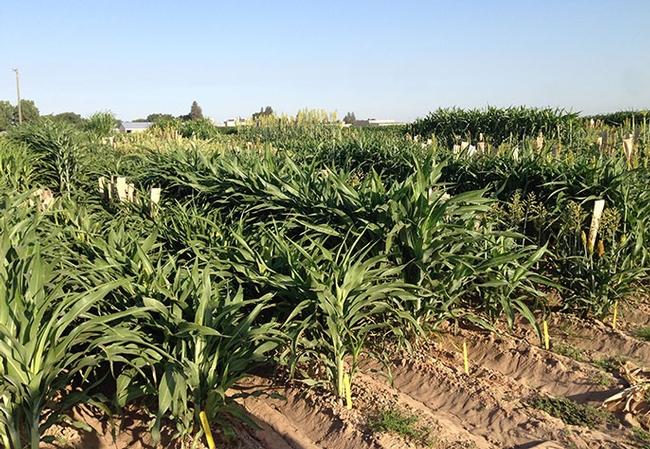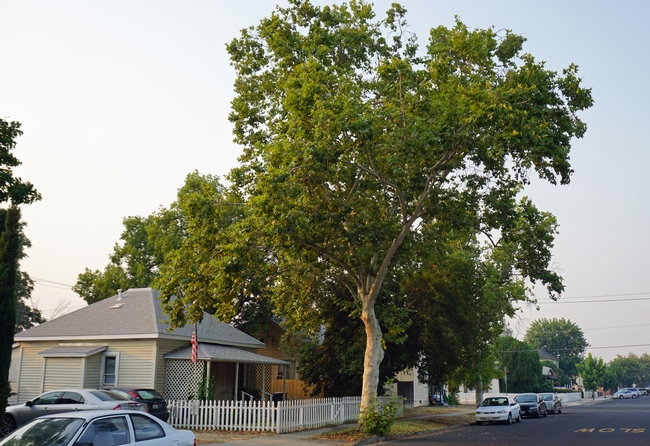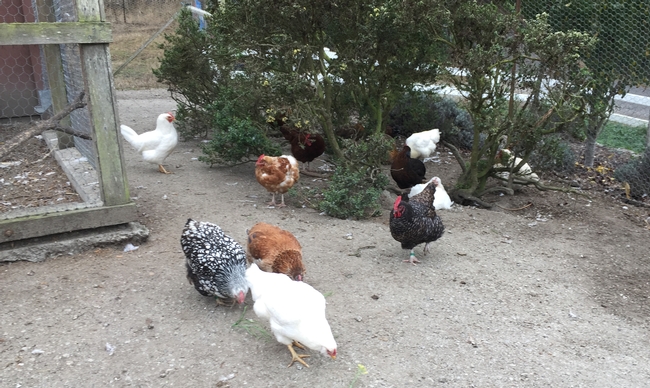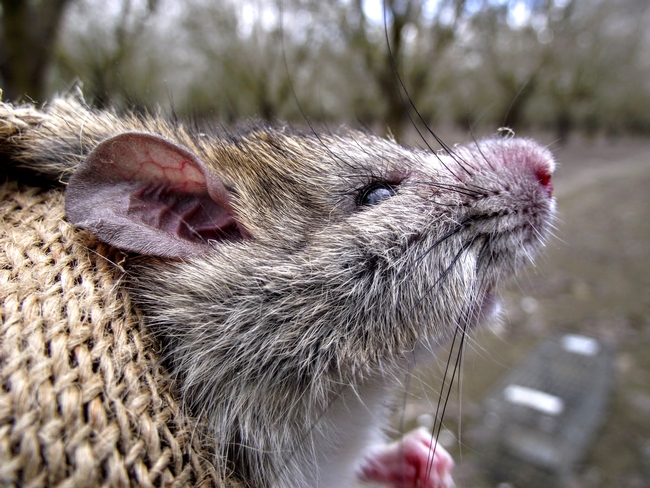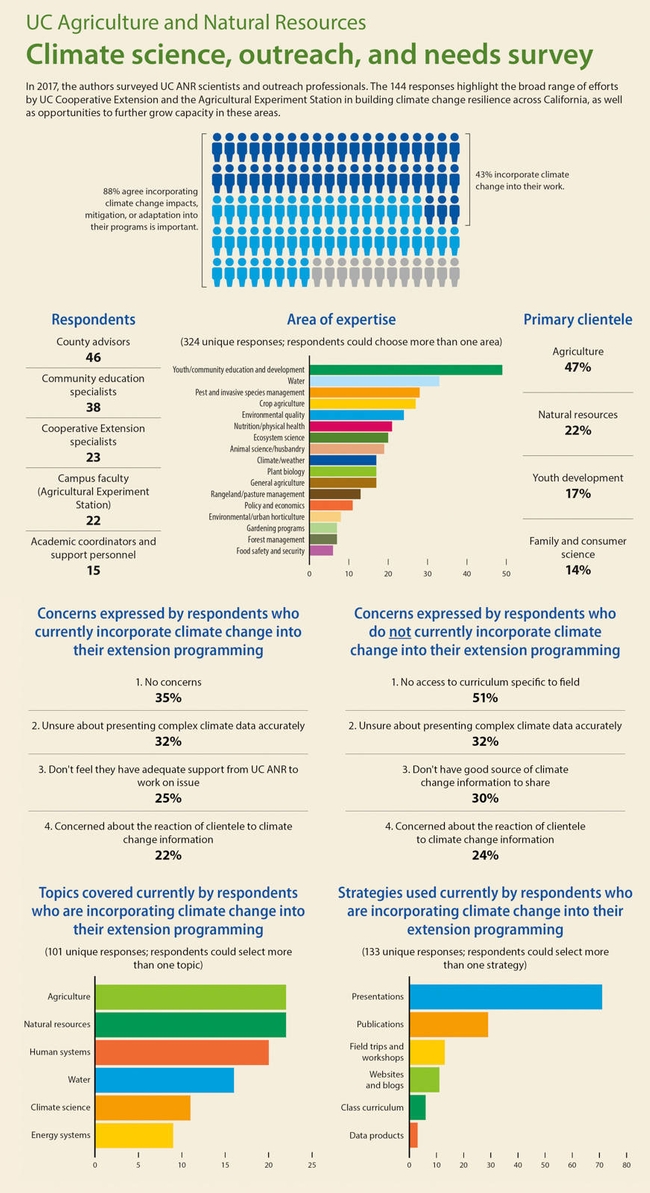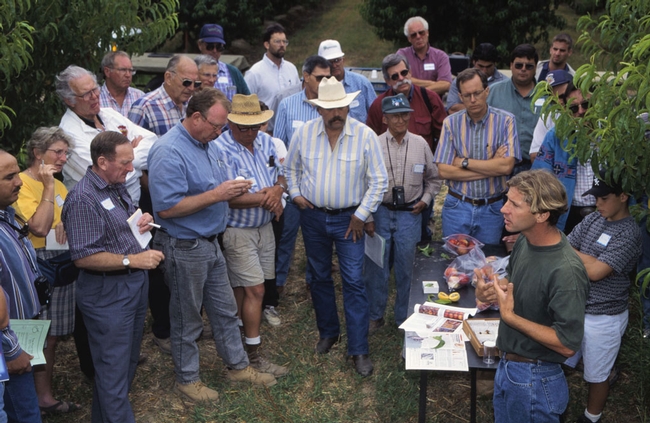Posts Tagged: Tapan Pathak
Two UCCE agricultural climate leaders recognized at the 6th California Climate & Agriculture Summit
Five California leaders, including two UC Cooperative Extension scientists, were recognized for their contributions to the field of agriculture and climate change at the California Climate & Agriculture Summit at UC Davis on March 5, 2019, said a news release issued by California Climate & Agriculture Network (CalCAN).
The summit was organized by CalCAN and brought together some of the state's foremost experts in agriculture — including farmers, agriculture professionals, researchers, advocates and policymakers — to grapple with the challenges of climate change and share knowledge about the opportunities facing the industry.
At the summit, CalCAN presented the leadership award for agricultural professional to Ruth Dahlquist-Willard, UC Cooperative Extension small farms advisor in Fresno and Tulare counties.
Dahlquist-Willard helps keep small-scale, diversified farmers in business by providing support with marketing, regulatory compliance, processing of value-added products, water and energy efficiency, and integrated pest management. She has been a driving force behind increasing access by Hmong farmers in the Fresno area to California's State Water Efficiency and Enhancement Program (SWEEP). Dahlquist-Willard has promoted the program, provided thousands of hours of one-to-one, culturally-relevant support to farmers on grant applications, and assisted with project design and installation. The farmers she has supported are now benefiting from water, energy and financial savings.
"There are large environmental problems to solve in the Central Valley, and it's time for a different conversation around farming there," Dahlquist-Willard said. "I feel that there needs to be a conversation in the middle to solve problems rather than a conflict-based approach."
The leadership award for researcher was presented to Tapan Pathak, UC Cooperative Extension specialist for climate adaptation in agriculture, based at UC Merced.
Pathak is the chair of the UC Cooperative Extension Climate Change Adaptation Workgroup, which brings together scientists across the UC system to collaborate on research and extension projects related to climate change adaptation in California agriculture. Pathak is the lead author on an important and timely paper that was published in 2018 in the journal Agronomy. It synthesizes the impacts of climate change on California agriculture and offers directions for future research and implementation.
"We need more facilitated dialog with policy researchers and scientists on the science of climate change, and the implications of not taking action," Pathak said. "Given the scale of California agriculture and the pressure of climate change impacts, we need even more substantial funding for incentives for farmers and for research and tools, and we must integrate growers from the beginning of the process."
The other CalCAN leadership awards were presented to the following:
Leadership Award for policymaker: Ken Alex, former Director of Governor Brown's Office of Planning & Research
Leadership Award for farmer/rancher: Ward and Rosie Burroughs, Burroughs Family Farm (Denair, CA)
Leadership award for legislative staff: Brett Williams, Office of Assemblymember Jacqui Irwin
UC Cooperative Extension works in local communities to help Californians adapt to climate change
Californians received bleak news last month when the state released its fourth assessment of climate change in California. The report predicts severe wildfires, more frequent and longer droughts, rising sea levels, increased flooding, coastal erosion and extreme heat.
“It's great to be living in a state where science and facts around climate change are valued,” said UC Cooperative Extension specialist Adina Merenlender, “but the recent forecasts may make you want to devour a quart of ice cream in a pool of salty tears.”
Modern civilization has changed the world climate, and even dramatic reductions in global greenhouse gas emissions at this point won't turn back the clock. The warming now predicted by Cal-Adapt is likely already “baked in,” even with our best mitigation efforts, said Igor Lacan, UC Cooperative Extension advisor in the Bay Area of California.
California has been a leader in facing the future climate head on. The state's first comprehensive assessment on climate change was produced in 2006 under then-Gov. Arnold Schwarzenegger. The second assessment, released in 2009, concluded that adaptation could reduce economic impacts of loss and damage from a changing climate. The third assessment was shaped by a request for more information on the adaptation options in the 2009 report. The fourth assessment was the first effort to break down global climate predictions and their impacts onto specific regions of California.
Author of the North Coast Region Report of the Fourth Assessment, Ted Grantham, praised state leaders for pushing forward efforts to slow climate change and adapt to the new weather conditions expected in California.
“California is playing a unique role in filling the void of leadership on this issue that the federal government was beginning to address under the Obama administration,” Grantham, a UC Cooperative Extension specialist based at UC Berkeley, said.
Across California, UC Cooperative Extension specialists and advisors are working in their local communities to prepare for warming temperatures and adapt to the changing climate. Following are examples of the efforts now underway.
Managing forests to survive the future
Among the suggested adaptation strategies in the 81-page North Coast Region Report, written by Grantham and his colleagues, the authors encourage government agencies and private forest owners to use prescribed fires and active forest management to reduce an overgrowth of trees and shrubs that fuel the more frequent and intense fires expected in the future.
Although climate change will create conditions conducive to catastrophic wildfire, the reason for dangerous forest overgrowth is related to decades of fire suppression on the landscape.
“Our forests are much denser and have more fuel buildup than they would have under a natural fire regime,” Grantham said. “Mechanical thinning, removing wood from the landscape and prescribed fires can help limit the impacts of wildfire.”
Native American tribes are being tapped to share their traditional ecological knowledge to inform this practice.
“Native Americans have used fire since time immemorial to manage their landscapes,” Grantham said.
Connecting habitats to allow species movement
When climate changes, plant and animal species may find their current habitats no longer fit the environment where they evolved. The fourth assessment technical report, Climate-wise Landscape Connectivity: Why, How and What Next, written by UCCE specialist Adina Merenlender, documented potential techniques to erase barriers to plant and animal movement.
“When we talk about wildlife corridors today, we might view a road as a barrier,” Merenlender said. “With climate change, the movement is over a much longer range for species to find suitable habitat at the end of the century.”
The report says research is needed to compare different approaches to designing climate-wise connectivity, determining how wide corridors need to be, and quantifying the impact of natural and anthropogenic barriers on possible range shifts.
California's wine industry is based on international varieties that come from Northern France, where the climate is cool, mild and consistent.
“They really require a cool to warm climate, not a hot climate,” said Glenn McGourty, UCCE viticulture advisor in Mendocino County.
There are many wine grape cultivars from Southern Europe – areas in Italy, Portugal and Spain – that are adapted to heat and make quality wines, but aren't well known. The varieties include Monepulciano, Sagrantino, Periquita and Graciano.
McGourty is studying how these cultivars perform in the warm interior of Mendocino County at the UC Hopland Research and Extension Center.
“We have many options as climates warm in the interior part of California to make wine that needs less amelioration in the winery compared to cultivars from Northern France,” McGourty said.
Recruiting and training climate stewards
The UC California Naturalist Program is moving full steam ahead with a new Climate Stewards Initiative to build engaged communities and functioning ecosystems that are resilient to changing climates.
California Naturalist, with trained volunteers across the state working with myriad conservation organizations, will be using its educational network to improve the public's understanding of climate change and engage the public in community action and local conservation.
“Climate stewards will offer in-person communication with your neighbors, tapping into science,” Merenlender said. “Improving climate literacy is an important outcome, but that won't happen through a website.”
Helping growers modify farming practices due to changing climate
USDA Climate Hub has awarded a grant to UC Cooperative Extension to support tools to assist growers in making strategic decisions in season and long term.
“We have many credible sources of weather and climate data, but often times we are challenged with translating it into decision support tools tailored to growers' needs,” said Tapan Pathak, UCCE specialist in climate change adaptation in agriculture. “It's too early to say which specific tools we will develop, but we are aiming to help farmers use weather and climate information in decision making processes.”
Pathak is also working with colleagues to analyze how generations of navel orangeworm, a significant almond pest, might shift for the entire Central Valley under climate change and how growers can adapt their practices to manage the higher pest pressure.
Using epigenetics to impart drought tolerance
At the UC Kearney Agricultural Research and Extension Center in Parlier and the UC West Side Research and Extension Center in Five Points, sorghum nurseries are being grown under drought and well-watered conditions to compare the environmental impacts on the plants' gene expression.
“We hope to tease out the genetics of drought tolerance in sorghum,” said Jeff Dahlberg, UCCE specialist, who is managing the trials at Kearney. “Using sorghum as a model, we expect this research to help us understand drought tolerance in other crops as well.”
Historically, the genetic manipulation of crops, which has been critical to increasing agricultural productivity, has concentrated on altering the plant's genetic sequence, encoded in its DNA.
Recent studies have shown that environmental stresses – such as drought – can lead to epigenetic changes in a plant's genetic information. Because epigenetic changes occur without altering the underlying DNA sequence, they allow plants to respond to a changing environment more quickly.
Cities can plant street tree species suited to future climate
Many common street trees now growing in the interior of California are unlikely to persist in the warmer climate expected in 2099, according to research published in the July 2018 issue of the journal Urban Forestry & Urban Greening. (Read the research report here until Sept. 27, 2018)
“Urban foresters in inland cities of California should begin reconsidering their palettes of common street trees to prepare for warmer conditions expected in 2099 due to climate change,” said the study's co-author, Igor Lacan, UC Cooperative Extension environmental horticulture advisor in the Bay Area.
Common trees in Coastal California cities appear to be better suited to withstand the 2099 climate.
“Our research shows that some trees now lining the streets of cities like Fresno, Stockton and Ukiah are likely to perform poorly in 2099,” Lacan said. “Those cities need to look at the conditions – and trees – now found in El Centro, Barstow and Fresno respectively.”
Trees to shade California in a warmer future
The changing climate predicted for California – including less rain and higher day and nighttime temperatures – is expected to cause chronic stress on many street tree species that have shaded and beautified urban areas for decades.
Realizing that popular trees may not thrive under the changing conditions, UC Cooperative Extension scientists are partnering with the U.S. Forest Service in a 20-year research study to expand the palette of drought-adapted, climate-ready trees for several of the state's climate zones.
“The idea is to look at available but under-planted, drought-tolerant, structurally sound, pest resistant trees for Southern California that do well in even warmer climates,” said Janet Hartin, UCCE horticulture advisor in San Bernardino County.
Twelve tree species were selected for each climate zone in the comparative study, with several area parks used as control sites.
Managing the forest for survival in warmer conditions
UC Cooperative Extension scientists are part of a collaborative research project with the University of Nevada, Reno, CAL FIRE and the U.S. Forest Service aimed at developing new strategies to adapt future forests to a range of possible climate change scenarios in the Sierra Nevada.
“It includes the idea that we may be struggling just to keep forests as forests, let alone having the species we value,” said Rob York, manager of UC Berkeley's Blodgett Forest Research Station near Georgetown.
Forests sequester a tremendous amount of carbon. As the climate changes, foresters will need to be proactive to reduce the risk of these massive carbon sinks becoming carbon sources.
“We're working to mitigate predicted impacts to forests, including regeneration failures, drought mortality and catastrophic wildfire,” Ricky Satomi, UCCE natural resources advisor in Shasta County.
At three separate study sites across the Sierra Nevada, novel approaches to forest management are being implemented to develop treatments that scientists believe will increase resilience, resistance and adaptability of Sierra Nevada mixed conifer forests.
The 2018-21 project is led by Sarah Bisbing, forest ecology professor at the University of Nevada, Reno, and funded with $2.7 million from CAL FIRE.
Climate change impacts on vulnerable communities
The latest climate assessment also reports on the serious nature of climate threats to vulnerable communities and tribal communities in California, with a focus on working collaboratively with these communities on research and solutions for resilience.
“The impacts of climate change will not be experienced equally among the population,” Grantham said. “The most significant public health and economic impacts – from flooding, extreme heat, air quality degradation, etc. – will be disproportionately experienced by vulnerable populations, including people of color, the poor and the elderly.”
The assessment includes a Climate Justice Report, which shares the idea that no group of people should disproportionately bear the burden of climate impacts or the costs of mitigation and adaptation. The report suggests collaborating with these communities on research and solutions for resilience.
March news clips
Unprecedented Study Discovers what Urban Coyotes Really Eat
(Care2) Laura Goldman, March 30
Hiking boots, avocados, candy wrappers and fast-food containers. These aren't a few of my favorite things, but they are some of the items found inside the stomachs of dead urban coyotes in Los Angeles and Orange counties.
…Since the study began over a year ago, the researchers, led by Dr. Niamh Quinn, the human-wildlife interactions advisor for the University of California Cooperative Extension, have discovered that cats make up only about eight percent of a coyote's diet.
https://www.care2.com/causes/unprecedented-study-discovers-what-urban-coyotes-really-eat.html
Red blotch grape virus confirmed in Calaveras
(Calaveras Enterprise) Jason Cowan, March 29
Red blotch virus, a DNA infection that decreases a grape's sugar levels on the vine, has been confirmed in Calaveras County, officials said last week.
After confirmed cases of the virus were located recently in El Dorado and Amador county vineyards, University of California Cooperative Extension Farm Adviser Lynn Wunderlich saw what she thought were symptoms of the virus in Calaveras and recommended farmers test for red blotch.
The results came back positive.
http://www.calaverasenterprise.com/news/article_4ebae972-33aa-11e8-ab5c-cb61df3e8deb.html
Raising chickens at home? Get their eggs tested for free
(Daily Democrat) ANR News release
Californians who raise poultry outdoors are invited to get their eggs tested for contaminants.
To find out if harmful substances on the ground that are eaten by hens get passed along in the eggs they lay, Maurice Pitesky, UC Cooperative Extension poultry specialist at the UC Davis School of Veterinary Medicine, is providing free egg testing.
“We're trying to understand the connection between the environment that backyard poultry are raised in and the eggs they are producing,” Pitesky said.
http://www.dailydemocrat.com/article/NI/20180329/FEATURES/180329815
Here's what trade tariffs could mean in Merced County, where nuts are big business
(Merced Sun-Star) Thaddeus Miller, March 28
China has threatened retaliatory tariffs on a select group of exports from the U.S. following President Donald Trump's plan to impose tariffs on steel and aluminum imports.
China's tariffs would first hit U.S. products such as avocados and nuts, with 15 percent duties. Beijing, if officials deemed it worthwhile, could also place 25 percent tariffs on American-made goods such as pork and aluminum.
…"It doesn't really matter which one it is, whether it's alfalfa, almonds or wherever it may go," said David Doll, a farm adviser with the Merced County UC Cooperative Extension. "They're as much political as they are anything else."
Nuts are big business in Merced County, where almonds are the second largest commodity at $578.5 million, according to the 2016 Merced County Crop Report, the most recent available. Almonds, pecans and pistachios bring in tens of millions of dollars more.
Out of every dollar made on a farm in the Central San Joaquin Valley, half pays for salaries and 40 cents goes to pay for supplies, Doll said, citing UC cooperative studies.
"Farms are businesses, and if they aren't profitable they're not going to stay in business," Doll said.
http://www.mercedsunstar.com/news/business/agriculture/article207155554.html
A film you may want your favorite doctor, trainer, chef and lawmaker to see
(Farm Week Now) Mike Orso, March 28
In the documentary “Food Evolution,” scientist Alison Van Eenennaam captures a smartphone selfie image of her with Bill Nye, the “Science Guy,” following a spirited forum in New York City on genetically modified organisms or GMOs. That was three years ago. Now, Van Eenennaam has young people coming up to her asking for selfies.
“If we can engage this next generation with critical thinking skills and trying to get to the bottom of what actually is true, I think we will have accomplished our job,” said Van Eenennaam, a University of California-Davis Extension specialist and one of several scientists featured in the film.
http://farmweeknow.com/story-film-may-want-favorite-doctor-trainer-chef-lawmaker-1-173628
Scientists say regulation stifles many new biotech traits
(Agri-Pulse) Jim Weber, March 28
Federal regulation of agricultural biotechnology needs to be based on risk and not on process, a wide range of scientists and food industry executives agreed at the Agri-PulseAg and Food Policy Summit. Coincidentally, a similar message was delivered a day later by a Council on Agricultural Science and Technology (CAST) task force.
“Scientists have been screaming that for 30 years,” said Alison Van Eenennaam, a cooperative extension specialist in animal genomics and biotechnology at the University of California-Davis. “That's where regulation should be.”
…Although the USDA, universities and small businesses have developed dozens of GE crops – with improved traits ranging from healthier and less allergenic to safer and more environmentally sustainable – and carried many through safety and pre-market testing, almost all have been denied commercial release mainly because of U.S. regulatory obstacles,” according to the CAST task force, led by Alan McHughen, who chairs the Department of Botany and Plant Sciences at California-Riverside.
https://www.agri-pulse.com/articles/10764-scientists-say-regulation-stifles-many-new-biotech-traits
If China Strikes Back On Tariffs, California Tree Nut Exports Could Take A Hit
(CapRadio) Julia Mitric, March 27
California agriculture could find itself caught in the middle of the U.S. — China trade dispute.
After President Trump ordered a 25 percent tariff on imported steel and a 10 percent tariff on imported aluminum last week, China hit back, announcing it may impose a 15 percent tariff on agricultural exports from the U.S.
The U.S. faces competitors for every agricultural product it exports. California wines, for example, compete with wines from New Zealand and Chile. If China hits the U.S. with a 15 percent tariff on wine, that's a problem, explains Dan Sumner, Director of the University of California Agricultural Issues Center.
"We may think California wine is special, but not everybody does,” Sumner said. "And if it's 15 percent more expensive than it used to be because of the tariff, there'll be a substantial reduction in how much gets sold in China."
State senator to honor UC 4-H program
(Morning Ag Clips)
California State Senator Ben Hueso will honor California and Baja California 4-H with a resolution in the State Senate at 2 p.m. April 2 to recognize the cross-border team that established a 4-H Club in Mexicali, Baja Mexico, in January 2017.
Last year, UC ANR Vice President Glenda Humiston signed a memorandum of understanding with the Baja California Secretary of Agriculture Development, Manuel Vallodolid Seamanduras, to offer UC's 4-H expertise to youth south of the border. The agreement increases the academic, scientific, technological and cultural cooperation that are part of UC President Janet Napolitano's Mexico Initiative.
https://www.morningagclips.com/state-senator-to-honor-uc-4-h-program/
Building an IPM Program to Fight Fruit Flies
(Growing Produce) David Eddy, March 26
When faced with spotted wing drosophila (SWD), it's critical for growers to keep in mind this is almost certainly unlike any pest they have dealt with before. That's because it's one of two species — out of a potential 1,500-plus — that feeds on healthy, not rotting, fruit.
That's certainly not the end of growers' difficulties with SWD, says Jhalendra Rijal, University of California Cooperative Extension Area IPM Advisor, Northern San Joaquin Valley. It's tricky because vinegar flies — the tiny flies often found circling above fruit bowls on kitchen tables — are so ubiquitous. Even the oh-so-common name, “fruit flies,” indicates the pests' omnipresence.
http://www.growingproduce.com/fruits/building-ipm-program-fight-fruit-flies/
Stallion Springs 4-H Swine Group visits local swine breeder
(Tehachapi News) Olivia Loyd, March 24
Tim Sturm, owner and operator of California Swine Services, farrowed approximately 600 piglets this year which will be shown all over California by 4-H and FFA members who take them to fairs and jackpot shows.
Sturm, who has a passion for teaching today's youth about raising swine, allowed the members of the Stallion Springs 4-H swine group to come to his facility on March 17 to learn to process one-day-old piglets. The kids learned to ear notch, dock tails, administer shots and clip needle teeth. Members learned why these processes are necessary, how to do them cleanly and correctly, and last were actually able take part in the process. They also learned valuable information about pig breeding and husbandry.
World Water Day
(KCAA) Water Zone, March 22
For World Water Day, Glenda Humiston discusses UC water research and what UC is doing to help ensure farmers and other Californians and the environment get the water they need. She also explains the Farm Bill. Humiston is introduced around the 30 min mark.
http://podcasts.kcaastreaming.com/water/ http://youtu.be/hN5pxvVI42A?a
Small Farms Must Include Marketing
(Cal Ag Today) Jessica Theisman, March 22
Mark Gaskell is with the University of California cooperative extension as a small farm and Specialty Crop Advisor for San Luis Obispo County. Gaskell recently told California Ag Today about his work with growers and small farms in the county since 1995.
“Part of my job has to do with applied research and educational programs, and this case related to keeping small farms viable and successful,” Gaskell said. “These activities include troubleshooting problems, helping growers develop new crops and develop new market opportunities that make them more competitive.”
https://californiaagtoday.com/small-farms-must-include-marketing/
How Biocontrols Fit into a Traditional Pest Control Program
(Growing Produce) Carol Miller, March 21
One of the great strengths of using biocontrols is that it allows growers to use traditional chemistries less often, says Surendra Dara, Strawberry and Vegetable Crop Advisor with the University of California Cooperative Extension. Dara was speaking to a packed room at the Biocontrols USA West conference in Carlsbad, CA, hosted by Meister Media Worldwide, the parent company of American Vegetable Grower.
http://www.growingproduce.com/vegetables/biocontrols-fit-traditional-pest-control-program/
Has the California dairy industry gone sour?
(Agri-Pulse) Tyler Ash, March 21 (Subscription only)
Rumors are circulating that a stampede of California dairy producers is heading toward greener pastures in other states. But why?
Experts in the nation's No. 1 milk-producing state have been ruminating on this dilemma for over a decade now, and it seems to stem from the same problems that are plaguing farmers all over America. Typical of the ag industry in general, mom-and-pop farms are going by the wayside and more large-scale farms are increasing production. So, the production seems to truck along but the number of players in that production does not.
“I remember being a kid, driving up I-5 and there were dairies all over the darn place,” said Jeff Stackhouse, livestock adviser for the University of California Cooperative Extension in Humboldt and Del Norte counties. “Now there's one.”
Statistics from the California Department of Food and Agriculture back him up. According to the agency, the state had 1,563 dairies in 2012 and four years later the number was 1,392, an 11 percent decline. The drop was 4 percent from 2015.
...Frank Mitloehner, professor of Animal Science at UC-Davis and a UC Cooperative Extension specialist, said California has lost approximately one fourth of its dairies over the last 15 years. His research focuses primarily on air quality related to livestock production and specified that the number of dairy cows in California hasn't actually decreased, just the number of dairies. He confirmed that most of the dairies that have closed were relatively small and weren't as competitive in today's market.
“The small ones often have a harder time in a strongly regulated environment,” Mitloehner said. “Large dairies generally hire some consultants to deal with air and water regulations to get their dairies to comply, but many small folks lack resources.”
According to Betsy Karle, dairy farm adviser for the University of California's Department of Agriculture and Natural Resources (UC ANR), the primary regulation that significantly affected California dairy producers was the General Order of Waste Discharge Requirement that was implemented by the Regional Water Quality Control Board in 2007, which affected approximately 1,400 dairies in California's Central Valley.
https://www.agri-pulse.com/articles/10689-has-the-california-dairy-industry-gone-sour
'Buy local' food programs deceive consumers and are rarely enforced, a USA TODAY Network investigation finds
(The Republic) Robert Anglen, March 20
As local-food sales grow into a $20 billion industry, a USA TODAY Network investigation found that state-branding programs designed to inform consumers and support local farmers are deceptive and virtually unregulated.
These "buy local" programs purport to connect shoppers with food from their states by affixing logos and stickers.
…"The word local is chic; it sells things," said Cindy Fake, horticulture and small-farms adviser for the University of California Cooperative Extension. "So it's used by everybody and anybody."
Fake said the word "local" has no clear definition and consumers are easily misled.
"They are likely to be deceived," she said. "Consumers are thinking one way and the marketers know that. They know consumers want local, so they say it's local."
… "There is a huge diversity across states about what is local," said Gail Feenstra, deputy director of the Sustainable Agriculture Research and Education Program at the University of California Division of Agriculture and Natural Resources.
Feenstra said there is more transparency on fresh produce because it's easier for consumers to identify where it came from and recognize regional products on store shelves.
But shoppers need to do their research, she said.
Roof Rat Damage Causing Concern for Growers
(AgnetWest) Brian German, March 16
Typically more of a problem in urban areas, roof rat damage is causing significant concern for farmers. According to University of California Agriculture and Natural Resources (UCANR) scientists, roof rats are appearing in considerable numbers this year. Researchers suggest monitoring fields for rodent activity and using bait stations before the growing season to prevent problems from developing further.
http://agnetwest.com/roof-rat-damage-causing-concern-growers
Valley farmers welcome rainstorms
(KFSN-TV) Reuben Contreras, March 15
Rain in the valley and snow in the Sierra from the last few weeks is adding to the water supply local farmers count on to grow their crops.
…"During the strawberry season if you have too much rain it is going to cause the fruit to rot," said Michael Yang of the UC Cooperative Extension Fresno County. "So during the full harvest, we don't want any rain."
Yang works with smaller growers in Fresno County. He says almost all of them rely on groundwater and wells to grow Asian specialty crops sold at farmer's markets.
http://abc30.com/weather/valley-farmers-welcome-rainstorms/3221598/
Pedestrian Orchards Will Reduce Injuries
(California Ag Today) Jessica Theisman, March 14
California Ag Today recently spoke with Becky Phene with the University of California out of the Kearney ag center. She's working alongside Kevin Day, UC tree fruit advisor in Tulare County, on development of pedestrian orchards.
"My background is irrigation. I got asked to participate in the pedestrian orchard with Kevin because he wanted to demonstrate multiple technologies that would be beneficial not just now, but in the future,” Phene said.
Day has combined his pedestrian orchard with subsurface drip irrigation. The pedestrian orchards are by design kept short so that there is no usage of ladders. Eliminating the usage of ladders can help prevent on the job accidents.
“The pruning lets the tree grow quickly and fill in as quickly as possible in the first couple of years, and then he develops the shape of the canopy and the shape of the leaders,” Phene said.
https://californiaagtoday.com/pedestrian-orchards-will-reduce-injuries/
Whole orchard recycling has promise for new almond plantings
Western Farm Press) Tim Hearden, March 14
When it comes time to push out old almond orchards, grinding them into the ground will improve soil nutrients for the next planting, a University of California Cooperative Extension researcher has concluded after years of studying the practice.
Whole orchard recycling increases soil organic matter and carbon, soil nutrients, and microbial diversity, leading to better productivity for the new trees planted in the old orchard's place, says Brent Holtz, pomology farm advisor in the UCCE office at Stockton, Calif.
http://www.westernfarmpress.com/tree-nuts/whole-orchard-recycling-has-promise-new-almond-plantings
California Almonds Are Back After Four Years of Brutal Drought
(Bloomberg) Alan Bjerga, Donna Cohen and Cindy Hoffman, March 14
After dropping during the drought, the 2017 almond crop rebounded to a record 2.14 billion pounds of shelled nuts. That's more than triple the amount of walnuts, the No. 2 U.S. nut, and more than four times that of pistachios, which are emerging as a serious competitor for California acreage. Almonds are “incredibly versatile,” said Daniel Sumner, an economist at the University of California, Davis. “And California is the best place to grow it. Where else can the weather be hot and dry and perfect, but you also have a system where you can bring water from mountains full of snow?” Almond-picking is also highly mechanized, which attracts farmers concerned about migrant-worker labor shortages, and its long history in the state creates a level of expertise competitors can't match, he said.
https://www.bloomberg.com/graphics/2018-thirst-for-almonds
International delegation will be looking for trade, research partners
(Sacramento Business Journal) Mark Anderson, March 13
Subscription only. Article based on ANR news release http://ucanr.edu/News/?blogpost=26598&blogasset=44547.
The What, When, and Why of Using Microbials on Your Farm
(Growing Produce) Robin Siktberg, March 12
Why should microbial controls be a part of an Integrated Pest Management (IPM) program? The first, and main one, is that research shows that they work. Many microbial products in the market today are backed by trial data that shows when used correctly, microbials can be a very effective way to improve plant health, suppress pest pressure, and improve yields.
“Microbials are very powerful tools,” says Dr. Surendra Dara, Strawberry and Vegetable Crops Advisor at University of California Cooperative Extension. “They have a number of benefits for the grower. Microbial control agents are either very specific (as with some viruses or Bt) or can attack a broad range of pests (as with fungi). They can have multiple modes of action, which prevents development of pest resistance. They are very safe for workers and consumers, and are a sustainable control option.”
Roof rats are invading California farms and destroying fruit, nuts and irrigation lines
(Fresno Bee) Robert Rodriguez, March 12
Roof rats, a common problem for city dwellers, are migrating to California farms and nibbling on everything from avocados to irrigation tubing.
University of California scientists say last year's wet weather created a perfect environment for the quick-breeding rats to flourish.
…"Rodents are everywhere and they are opportunists," said Rachel Long, a University of California, cooperative extension adviser. "They move in from their surrounding urban habitats to take advantage of any food source they can find. And once that food source disappears they search for food elsewhere."
http://www.fresnobee.com/news/business/agriculture/article204696074.html
Do Backyard Chickens Need More Rules?
(KQED) Menaka Williams, March 12
…It was easy to welcome another chicken, partly because Oakland's local policies for keeping poultry aren't that restrictive. Roosters aren't allowed, and hens just have to be housed at least 20 feet from any house. That's it. No rules about the number of birds, their coops, slaughter or care. Bare-bones local laws around chickens are really common, says Catherine Brinkley, a veterinarian and urban planner at the University of California, Davis.
Brinkley says these policies tend to focus on limiting nuisances, like early morning cock-a-doodle-dos or eyesore coops — leaving a gap in codes when it comes to health and safety. "They're not at all focused on public health considerations, like [requiring] training for new owners in washing hands and selling eggs, nor do they think about if somebody is hoarding chickens or other awful things that, quite honestly, happen with animal welfare," Brinkley says.
https://www.kqed.org/bayareabites/125604/do-backyard-chickens-need-more-rules
OPINION Farm Bill must include climate change adaptation
(Redding Record Searchlight) Marty Walters, March 9
A new study published by a group of University of California researchers led by Tapan Pathak, published in the journal Agronomy, provides a whole new level of analysis in the ways that California's agriculture will change and be stressed by our changing climate, and it recommends ways to reduce some of the negative effects.
OPINION The self-inflicted economic damage to American agriculture
(The Hill) Daniel Sumner, March 9
Agriculture is so fully integrated into world markets that consumers everywhere take for granted that ripe peaches will be available to everyone, everywhere in January, while Zinfandel, Shiraz and Prosecco are universally available. Likewise farmers all over the world use tractors made in America, and tomato processors use equipment from Italy.
Study indicates that climate change will wreak havoc on California agriculture
(LA Times) Michael Hiltzak, March 9
The California we know is the breadbasket of the nation, producing more than two-thirds of the country's fruits and nuts, including almonds, pistachios, oranges, apricots, nectarines and prunes, and more than a third of its vegetables, including artichokes, broccoli, spinach and carrots. It's all valued at more than $50 billion a year.
http://www.latimes.com/business/hiltzik/la-fi-hiltzik-climate-agriculture-20180309-story.html
Precise gene technology impacts GMO debate
(Capital Press) Tim Hearden, March 8
Precise gene-editing technology is bringing the debate over genetically modified crops into a new era, researchers and experts say.
While the use of GMOs has ignited a high-pitched public debate for years, the ethical and socioeconomic debate over the newer techniques “seems to be keeping pace with the science,” observes Neil McRoberts, a University of California-Davis associate professor and plant pathologist.
http://www.capitalpress.com/SpecialSections/Seed/20180308/precise-gene-technology-impacts-gmo-debate
Trade war could spark food fight, California growers fear
(LA Times) Geoffrey Mohan, March 2
Steel and aluminum may be the intended quarry of a trade war that President Trump has said would be "good" for the U.S. economy, but the casualties of the conflict could be food, agricultural economists warn.
… No state has more at stake than California, which leads the country in agricultural revenue. Farmers and ranchers in the Golden State are twice as dependent on foreign trade as the country as a whole. World leaders also likely know that Trump enjoyed deep support in rural, agricultural areas, including much of the Central Valley, said Dan Sumner, an economist who directs the Agricultural Issues Center at UC Davis.
http://www.latimes.com/business/la-fi-trade-war-agriculture-20180302-story.html
Building climate change into the work of UCANR
UC Cooperative Extension researchers convey need for more climate change communication and curriculum tools
Reducing greenhouse gas emissions from natural and working lands is one of California's key climate change strategies. In particular, the potential for farm and rangeland soils to serve as carbon sinks has been getting a lot of attention lately in the national media — and during California Healthy Soils week, which wrapped up Dec. 7.
These are areas where UC Cooperative Extension, with its local presence across the state, is well-positioned to drive change. But as a recent survey of UCCE advisors, specialists and faculty found, while there is a good deal of climate work happening, there are also some significant obstacles.
The survey results — reported in an article by UCCE academics Ted Grantham, Faith Kearns, Susie Kocher, Leslie Roche and Tapan Pathak in the latest issue of California Agriculture — showed that while nearly 90 percent of respondents believe it is important to incorporate climate science into extension programming, only 43 percent currently do so.
Respondents pointed to a number of issues. One was "limited familiarity with climate science fundamentals." It's one thing to cite the overwhelming scientific consensus that climate change is real and is being driven largely by human activity; it is another to be able to respond quickly and convincingly to detailed questions from doubters. This list from Grist, for instance, details more than 100 common arguments raised by climate skeptics, many of which have non-trivially complex answers.
Another important issue cited by respondents was "fear of alienating clientele by talking about a contentious topic," a response that highlights the importance of personal relationships in UCCE's work, and the challenge of communicating an area of science that is highly politicized.
The authors conclude: "To further increase the capacity of UC ANR staff to support the needs of their clientele and the broader public, professional development around climate science fundamentals, communication, and adaptation strategies is critical." As an initial follow-up, the UCANR climate change program team (led by authors Grantham, Kocher and Pathak) is presenting a workshop and professional development meeting for extension professionals in February.
For more from California Agriculture, the research journal of UCANR, see the full issue with articles on mapping soil salinity in the San Joaquin Valley via satellite; choosing forage seed mixes for rangeland restoration; growing oilseeds in winter without irrigation; keeping dairy cows cool in the summer; breeding better carrots; and more.
'Science' details an unconventional academic path
Throughout the United States, Cooperative Extension's 13,000 academics use new technologies to help solve problems faced by farmers, industries, natural resource managers and local communities, reported John Tibbetts in the AAAS publication Science.
The article included the thoughts of two relatively new UC Cooperative Extension academics and outlined a new UC program to support graduate students interested in cooperative extension careers.
Distinct skills are needed to be an effective cooperative extension academic. The role requires the ability to know and understand how to work with and through people, how to bring about change in communities and how to engage buy-in at the grassroots level.
"You should have good listening skills," added Lenya Quinn-Davidson, UC Cooperative Extension area fire advisor based in Humboldt County.
Quinn-Davidson also said she likes the diversity of her job. “I can be out in the field and then do a radio interview, work on a grant application, or host an event, and I'm always building relationships," she said.
John Battles, forest ecology professor at UC Berkeley said Cooperative Extension can offer an alternative academic career track for many students, but they need a way to learn the skills needed for extension success.
“In extension, you must communicate science effectively to the general public, and you don't have a 50-minute lecture to do it. You need to know how to facilitate a productive discussion in a public meeting, how to run that meeting so that everyone is heard,” he said.
To prepare students for extension jobs, UC Berkeley launched the Graduate Students in Extension program. The internship offers up to a year of funding for graduate students to conduct applied research projects and learn the principles of outreach.
Tapan Pathak, UC Cooperative Extension specialist in climate change adaptation in ag, also commented Tibbetts' article. He said extension specialists have the academic freedom to undertake research in their field as long as it addresses the needs of their clients.


